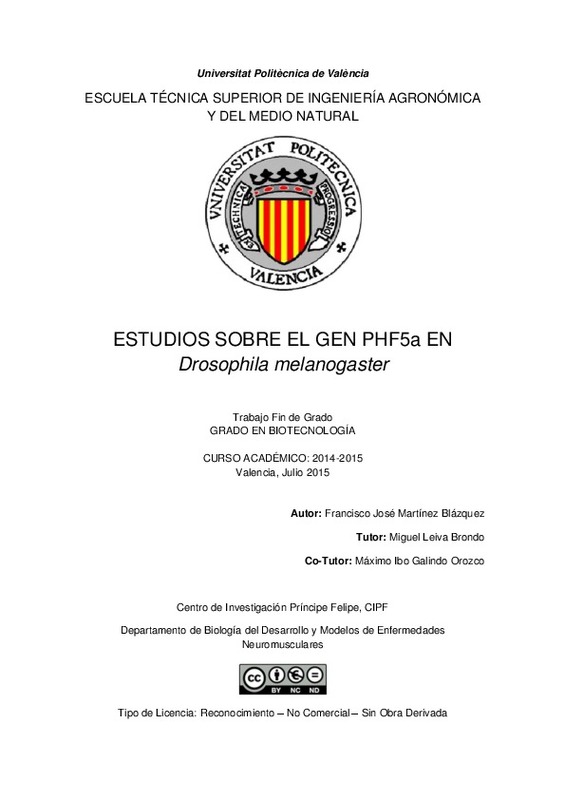|
Resumen:
|
[ES] Drosophila melanogaster posee el gen CG4598 que codifica la proteína, Ini, que parece ser que interviene en el splicing y procesos de transcripción en multitud de especies. En el TFG se realizarán 3 experimentos. En ...[+]
[ES] Drosophila melanogaster posee el gen CG4598 que codifica la proteína, Ini, que parece ser que interviene en el splicing y procesos de transcripción en multitud de especies. En el TFG se realizarán 3 experimentos. En dos, se utilizará la técnica de RNA interferente para el silenciamiento del gen y se observará el fenotipo en una región del ala (venas 3 y 4) y en los discos imaginales, utilizando immunohistoquímica para evaluar la muerte celular o reducción en la proliferación. En el tercero se contarán moscas con sobreexpresión del gen y se observará si existe alguna deficiencia que produzca muerte prematura. A través del estudio de este gen, se puede completar lo que sabemos del splicing y los procesos de transcripción y, en un futuro, se puede averiguar si puede estar relacionado con alguna patología en humanos. El objetivo es determinar cuáles son las consecuencias fenotípicas del silenciamiento y sobreexpresión de este gen, con el fin de elucidar más información acerca de él.
[-]
[EN] The PHF5a protein has been described as a component of the spliceosomal complex.
Nervertheless, recent studies have demonstrated its implication as an essential factor
in certain tumors. On the other hand, little ...[+]
[EN] The PHF5a protein has been described as a component of the spliceosomal complex.
Nervertheless, recent studies have demonstrated its implication as an essential factor
in certain tumors. On the other hand, little is known about other processes such as
gene expression or cellular mitosis where it has been shown that PHF5a is involved
somehow. In the present study using Drosophila melanogaster as model organism,
overexpression and silencing experiments of PHF5a were conducted in order to assess
the resulting phenotypic changes.
Along the first part of the project, the protein was silenced throughout the whole body
and after that the silencing was directed against target organs by more stringent
expression systems. Thereafter, phenotypes were evaluated visually and by
microscope using image analysis. Furthermore, by studying the flies´ longevity the
effects of PHF5a overexpression were proved.
The results´ analysis demonstrates the protein´s critical role in the survival of the
organism, especially its requirement in larva development and fly metamorphosis. The
mechanism by which it acts is still unknown, although it seems to be related to the
process of cellular mitosis. Regarding the results of the overexpression, data are still
uncompleted and seem to be contradictory up to now.
Taking into account the previous considerations, this study shows PHF5a crucial
function in D. melanogaster´s development and its possible implication in cellular
processes nobody thought it could be involved. Thus, these facts may lead to
reconsider the existing information about PHF5a.
[-]
|







